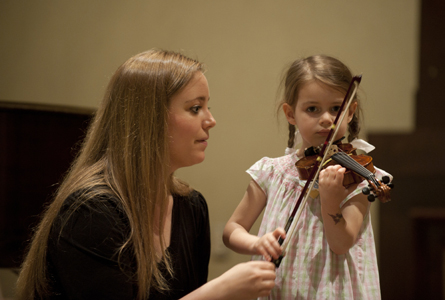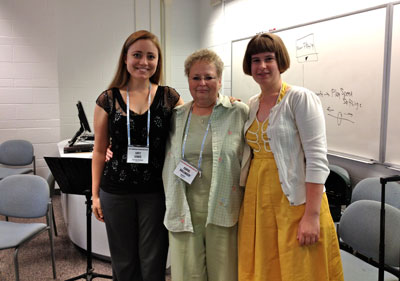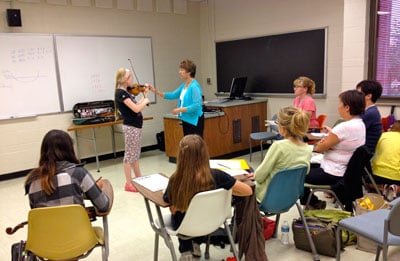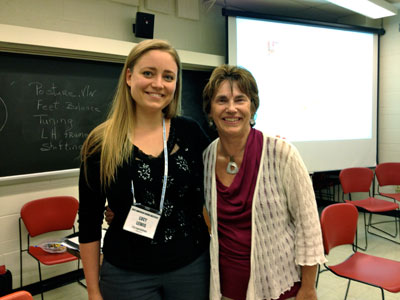We're grateful to have Lucy Lewis, a trained Suzuki teacher and doctoral student in musical arts at the University of Iowa, share a series of blogs about her experiences at American Suzuki Institute at the University of Wisconsin-Stevens Point. Every summer, the Suzuki Institute hosts a teacher training session at Stevens Point, and this summer Ms. Lewis is one of the teachers-in-training.This entry is Ms. Lewis's second dispatch from Stevens Point and, though it's hard to believe, it's even richer than her first. In this entry, Ms. Lewis shares her admiration for two master teachers at Stevens Point and describes their successful approaches to instruction. It's truly amazing to observe a master teacher at work; what's even more amazing, however, is to observe a developing master teacher – Ms. Lewis – learn her craft.  Since the last time I wrote I have completed the Suzuki teacher training for Violin Book 8 with Carol Dallinger (Oramay Cluthe Eades Distinguished Professor of Music at the University of Evansville and founder of the University of Evansville Suzuki Program), and I am currently in the midst of doing the training for Violin Book 5 with Nancy Lokken (Director of the Augsburg College Suzuki Program). Both of these ladies are incredible people and masterful teachers, and it has been a privilege to train with them. However, before I detail some of the things I have learned, I would like to share with you some thoughts of wisdom that were passed on to all the teacher trainees in our orientation meeting.
Since the last time I wrote I have completed the Suzuki teacher training for Violin Book 8 with Carol Dallinger (Oramay Cluthe Eades Distinguished Professor of Music at the University of Evansville and founder of the University of Evansville Suzuki Program), and I am currently in the midst of doing the training for Violin Book 5 with Nancy Lokken (Director of the Augsburg College Suzuki Program). Both of these ladies are incredible people and masterful teachers, and it has been a privilege to train with them. However, before I detail some of the things I have learned, I would like to share with you some thoughts of wisdom that were passed on to all the teacher trainees in our orientation meeting.
On the eve of starting our first week of teacher training, Pat D’Ercole (Director of the Aber Suzuki Center at the University of Wisconsin-Stevens Point) held a meeting which all the teacher trainees were required to attend. In this meeting she discussed the benefits of doing Suzuki teacher training and encouraged us all to approach our classes and observations with an open mind, no matter our background or current mindset about teaching. She acknowledged that we might see some things that would challenge our beliefs, but cautioned us to be willing to try things before making a judgment call. Evidently, John Kendall once told Waltraud Suzuki (the wife of Dr. Shinichi Suzuki), that he was not sure whether American mothers would be willing to do all that this method required and she replied to him in a heavy German accent – “Why don’t you try it first and then say something!” I for one, am grateful that he took her advice.
One last key thought from this meeting was some wisdom from John Kendall that Pat passed on to us, which is that whenever we study pedagogy and observe master teachers at work, we should always remember to look for PRINCIPLES of teaching versus “rules," avoiding a one-size-fits-all approach. There are no two students alike and even though there are “time-tested” tools that we can use to guide our teaching, we should always be ready and prepared to adapt to a student’s specific needs.
When the meeting concluded, all of this wonderful advice continued to stimulate my thoughts, and I was definitely ready to embrace the learning experience that these next two weeks would have to offer.
(Side note: to detail everything that I have been learning in my teacher training these past few days would be too much, and so for the purpose of this blog, I am only going to focus on a few things that I found to be especially pertinent and valuable to my own teaching.)
Suzuki Violin Book 8 Teacher Training with Carol Dallinger
 Carol started off our first morning of teacher training with a thoughtful discussion of what makes Suzuki teachers unique. She shared with us that she feels the essence of who we are is exemplified in these ways: that we focus on the hearts and character of children, that we are constantly learning from each other and sharing our ideas, and that we teach a shared literature which builds a sense of community. (It’s a beautiful thing to be able to play with other children, even if you don’t speak the same language!) We also dispute the mindset that you either have talent or you don’t. Our “magic” lies in the fact that we believe that ALL children do have talent, and we are going to help them find it within themselves.
Carol started off our first morning of teacher training with a thoughtful discussion of what makes Suzuki teachers unique. She shared with us that she feels the essence of who we are is exemplified in these ways: that we focus on the hearts and character of children, that we are constantly learning from each other and sharing our ideas, and that we teach a shared literature which builds a sense of community. (It’s a beautiful thing to be able to play with other children, even if you don’t speak the same language!) We also dispute the mindset that you either have talent or you don’t. Our “magic” lies in the fact that we believe that ALL children do have talent, and we are going to help them find it within themselves.
With this in mind, the question then was what role does Violin Book 8 play in the musical development of our students? The short answer is that Book 8 is a TONE developing book. One of Dr. Suzuki’s most famous quotes is that “tone has a living soul” and he firmly believed that a person’s tone reflects their heart (and character). There is not a lot in this volume that is “new” technically-speaking for the student to learn; rather it provides a sort of “plateau” opportunity for the student to fully develop their tone and musical expression through a deeper development of bow control (i.e. highway manipulation, thoughtful choices regarding weight and speed, refined articulation, etc.) In addition, the repertoire in this book requires a high level of left hand facility, (specifically for the “Allegro” movement from J.S. Bach’s Sonata in E minor for violin and the “Allegro con fuoco” movement of the Veracini Sonata).
 Out of the entire week, what I enjoyed most was to be able to sit and discuss the teaching points behind each of the pieces in Book 8 and then have the opportunity to watch Carol work with the students in her Book 8 masterclass. She has a gift for being able to zone in on the one thing that is hindering a student in their playing and then work with them in a very detailed way so that they are able to make extraordinary strides in their playing in just a short amount of time. Interesting to note was that often the one thing that was hindering a student could be traced back to a “basic” that needed to be fixed, such as a shoulder and/or chin rest set-up that did not allow the student to have a balanced violin posture, or a stiff thumb in the bow hold. This certainly gave me pause to think about how true it is that, even for those of us who are professional string players, something that we may be struggling with (however large or small) can often be traced back to a simple basic that we have not yet corrected and/or mastered.
Out of the entire week, what I enjoyed most was to be able to sit and discuss the teaching points behind each of the pieces in Book 8 and then have the opportunity to watch Carol work with the students in her Book 8 masterclass. She has a gift for being able to zone in on the one thing that is hindering a student in their playing and then work with them in a very detailed way so that they are able to make extraordinary strides in their playing in just a short amount of time. Interesting to note was that often the one thing that was hindering a student could be traced back to a “basic” that needed to be fixed, such as a shoulder and/or chin rest set-up that did not allow the student to have a balanced violin posture, or a stiff thumb in the bow hold. This certainly gave me pause to think about how true it is that, even for those of us who are professional string players, something that we may be struggling with (however large or small) can often be traced back to a simple basic that we have not yet corrected and/or mastered.
Having this observation experience definitely helped the concepts that we were discussing to “gel” for me, and I feel this is an invaluable component of the Suzuki teacher training experience.
Suzuki Violin Book 5 Teacher Training with Nancy Lokken
 This week, the big thing that I will be taking away from Nancy’s Book 5 class is that we as teachers must always have a vision for our students. It is not enough to just teach to the issues as they come up – we must be thinking and planning proactively, right from the very beginning, so that when we start a student on Twinkle we can be preparing the skills that they will need for Vivaldi and Bach concertos.
This week, the big thing that I will be taking away from Nancy’s Book 5 class is that we as teachers must always have a vision for our students. It is not enough to just teach to the issues as they come up – we must be thinking and planning proactively, right from the very beginning, so that when we start a student on Twinkle we can be preparing the skills that they will need for Vivaldi and Bach concertos.
Skill review has also been a huge topic in this class. Another item that sets the Suzuki Method apart from others is that we believe that “review is the glue,” and so we are constantly refining our skills through the repertoire that we have learned. As a practical assignment, Nancy asked us to go through each of the pieces in Book 5 and pick one skill that we can trace in Books 1-5. So, for example, in the first movement of Bach’s Concerto in D minor for two violins, I chose to trace the development of large, non-adjacent string crossings through the repertoire. The first time we see such a string crossing is in Bach’s Minuet No. 2 in Book 1 and it is so fascinating to trace the development of this advanced skill that starts at such a rudimentary level. Aside from being an insightful pedagogical exercise, this was an excellent reminder that we must always be teaching with the “end goal” in mind, no matter the students current level.
 Observations of Nancy’s masterclass were also an incredible experience. She, like Carol Dallinger, has the amazing ability to immediately zone in on what a student needs and succinctly introduce the steps to fix the problem. Posture was something that Nancy spent quite a bit of time focusing on with each student because a balanced, centered stance coupled with the proper equipment (shoulder rest and chin rest) are key to to the success of anything else that the student might be trying to do on the violin. Next to posture, Nancy’s other main focus was tone. She stressed that we must always have a concept of our sound before we start to play, and in our pedagogy classes she encouraged us to use textures, colors, visuals and even food to help describe the quality of different sounds to our students. A lot of young children need encouragement as they learn how to pull a deep, rich sound from their instruments, and so Nancy would often say to them, “Let’s go for more chocolate in your sound.” This of course meant that they needed to fully give the bow to the string and use more of their natural arm weight to sink in to the string as they pulled the bow. It was amazing to see the changes made in sound from the beginning of the week to the end.
Observations of Nancy’s masterclass were also an incredible experience. She, like Carol Dallinger, has the amazing ability to immediately zone in on what a student needs and succinctly introduce the steps to fix the problem. Posture was something that Nancy spent quite a bit of time focusing on with each student because a balanced, centered stance coupled with the proper equipment (shoulder rest and chin rest) are key to to the success of anything else that the student might be trying to do on the violin. Next to posture, Nancy’s other main focus was tone. She stressed that we must always have a concept of our sound before we start to play, and in our pedagogy classes she encouraged us to use textures, colors, visuals and even food to help describe the quality of different sounds to our students. A lot of young children need encouragement as they learn how to pull a deep, rich sound from their instruments, and so Nancy would often say to them, “Let’s go for more chocolate in your sound.” This of course meant that they needed to fully give the bow to the string and use more of their natural arm weight to sink in to the string as they pulled the bow. It was amazing to see the changes made in sound from the beginning of the week to the end.
There is so much that I have observed and learned in these past few days and right now I am not sure my brain can handle much more (I mean this in the best possible way of course!). It has been an absolute treat to learn from these master teachers, to observe pedagogy in practice, and to have stimulating discussions with my colleagues. As I prepare to leave Stevens Point I will be thinking about my job next week, which will be to 1) compile my notes, 2) just let everything “gel” in my brain, and then 3) decide what I want to incorporate in to my studio and how. I am looking forward to another year of teaching and will be happy to share my “organized” thoughts with you sometime next week as I am preparing for the new year, so stay tuned!


